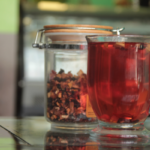I. Introduction
White tea has been gaining increasing interest among tea enthusiasts due to its delicate production process and numerous health benefits. In this article, we will explore the origins of white tea, its production process, and the various ways it can contribute to overall well-being.
II. What is White Tea?
White tea is a type of tea that is made from the young leaves and buds of the Camellia sinensis plant. It originated in China and has been consumed for centuries for its subtle and sophisticated flavor. There are several varieties of white tea, including Silver Needle, White Peony, and Longevity Eyebrow, each with its unique characteristics.
Compared to other types of tea such as green tea and black tea, white tea undergoes minimal oxidation during processing. This minimal processing allows the tea leaves to retain more of their natural antioxidants and nutrients, resulting in a lighter and milder flavor profile.
III. The Delicate Production Process of White Tea
The production of white tea involves a delicate and meticulous process to ensure the highest quality leaves are harvested.
A. Harvesting the Tea Leaves
The first step in producing white tea is the careful selection and harvesting of the tea leaves. Only the young tea buds and the top two leaves are picked. This ensures that the leaves are still tender and have a higher concentration of beneficial compounds.
B. Withering and Drying the Leaves
After harvesting, the tea leaves are spread out to wither under natural sunlight or in a controlled indoor environment. This withering process allows the leaves to lose some of their moisture content while retaining their natural flavors and nutrients.
Once the leaves have withered, they are carefully dried to halt the oxidation process. Unlike other types of tea, white tea undergoes minimal rolling or shaping, preserving the delicate appearance of the tea leaves.
C. Benefits of a Delicate Production Process
The delicate production process of white tea ensures that the natural attributes of the tea leaves are preserved. The minimal processing helps retain a higher concentration of antioxidants and beneficial compounds, which can contribute to various health benefits when consumed.
IV. The Health Benefits of White Tea
White tea is renowned for its numerous health benefits, thanks to its rich antioxidant content and anti-inflammatory properties.
A. Antioxidants and Anti-Inflammatory Properties
White tea contains high levels of antioxidants, such as polyphenols and catechins, which can help protect the body against free radicals and oxidative stress. These antioxidants also possess anti-inflammatory properties, reducing the risk of chronic diseases and promoting overall well-being.
B. Impact on Cardiovascular Health
Studies have shown that white tea may help improve cardiovascular health. The antioxidants present in white tea can help reduce cholesterol levels, lower blood pressure, and improve blood vessel function, ultimately reducing the risk of heart disease.
C. Mental Health and General Well-being
The consumption of white tea has also been associated with various mental health benefits. Its naturally occurring amino acids, such as L-theanine, can promote relaxation, enhance focus, and reduce stress and anxiety. Additionally, the mild caffeine content in white tea can provide a gentle energy boost without the jitters often associated with other caffeinated beverages.
V. How to Properly Prepare White Tea
To fully enjoy the delicate flavor and benefits of white tea, proper preparation is essential.
A. Ideal Temperature and Infusion Time
White tea is best brewed with water that has been heated to around 170°F (77°C). It is crucial to avoid using boiling water, as it can scorch the tender tea leaves and result in a bitter taste.
The recommended infusion time for white tea is approximately 2-3 minutes. However, brewing time may vary depending on personal preference and the specific type of white tea being used. It is advisable to experiment with different brewing times to find the perfect balance of flavor and strength.
B. Tips for Selection and Proper Storage
When purchasing white tea, it is important to choose high-quality loose-leaf tea from reputable sources. Loose-leaf white tea offers a more aromatic and flavorful experience compared to tea bags. Look for tea leaves that are light in color and have a fresh, delicate aroma.
To preserve the freshness and flavor of white tea, store it in an airtight container away from direct sunlight, moisture, and strong odors. Proper storage will ensure that the tea retains its delicate characteristics for an extended period.
VI. Ways to Enjoy White Tea Beyond Infusion
In addition to traditional infusion, white tea can be used in various culinary creations, adding a subtle and unique flavor profile to both beverages and food.
A. Iced Beverages with White Tea
White tea can be brewed and chilled to create refreshing iced teas. For a simple and elegant option, try brewing a batch of white tea and adding slices of fresh fruits, such as peach or strawberry, for a naturally sweetened and flavorful iced tea.
B. White Tea in Desserts and Savory Dishes
White tea can also be incorporated into desserts and savory dishes to add a touch of sophistication. For example, white tea-infused panna cotta can offer a delicate and creamy dessert experience, and white tea can be incorporated into marinades for meats or used as a flavoring in savory sauces.
VII. Conclusion
White tea, with its delicate production process, offers a unique and subtle flavor profile, along with numerous health benefits. The minimal processing ensures that the tea retains its antioxidants and nutrients, promoting overall well-being. By properly preparing white tea and exploring various culinary applications, individuals can fully appreciate the delicate taste and versatility of this exceptional beverage.
VIII. Conclusion
In conclusion, white tea is a remarkable beverage that combines a delicate production process with numerous health benefits. Its minimal processing allows the tea leaves to retain high levels of antioxidants, promoting cardiovascular health and overall well-being. By understanding the proper preparation techniques and exploring different culinary applications, individuals can fully experience and enjoy the delicate flavors of white tea. So why not embark on a journey of taste and wellness by incorporating white tea into your daily routine?






